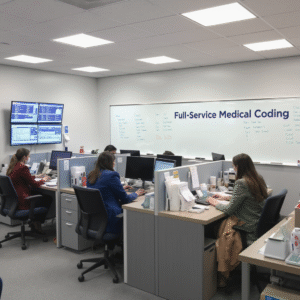Avoiding Common Mistakes in Family Practice Billing: A Comprehensive Guide for Healthcare Providers
Family Practice Billing
Family Practice Billing
Family practice billing can be a complex maze of codes, regulations, and documentation requirements. Even small errors can lead to claim denials, delayed payments, and compliance issues that significantly impact your practice’s revenue cycle. Understanding and avoiding these common pitfalls is essential for maintaining a healthy financial foundation and ensuring your practice can continue providing quality care to patients.

The High Cost of Billing Errors
Before diving into specific mistakes, it’s crucial to understand the financial impact of billing errors on family practices. According to industry studies, medical practices lose between 5-10% of their potential revenue due to billing mistakes and claim denials. For a typical family practice generating $1 million annually, this translates to $50,000-$100,000 in lost revenue each year.
Beyond immediate financial losses, billing errors can trigger audits, result in compliance penalties, and damage relationships with insurance providers. The administrative burden of correcting mistakes and resubmitting claims also diverts valuable time and resources from patient care.
Common Documentation Mistakes
Insufficient Clinical Documentation
One of the most frequent errors in family practice billing stems from inadequate documentation. Healthcare providers often focus on patient care while overlooking the detailed documentation required for proper billing. Insurance companies require comprehensive records that support the level of service billed and justify medical necessity.
Common documentation deficiencies include missing chief complaints, incomplete physical examinations, absent assessment and plan sections, and failure to document time spent on counseling services. Each encounter should tell a complete story that clearly demonstrates the complexity and necessity of services provided.
To avoid these issues, implement standardized documentation templates that prompt providers to include all required elements. Regular training sessions should emphasize the connection between clinical documentation and billing accuracy. Consider using electronic health record systems with built-in compliance checks that flag incomplete documentation before submission.
Inadequate Progress Note Details
Progress notes often lack the specificity needed to support billing codes. Vague statements like “patient doing well” or “continue current treatment” don’t provide sufficient detail for insurance companies to understand the complexity of care provided. Instead, progress notes should include specific details about symptom changes, response to treatment, medication adjustments, and future care plans.
Family practices should establish clear documentation standards that require quantifiable measurements, specific symptom descriptions, and detailed treatment responses. Train staff to recognize when additional documentation is needed and implement quality assurance processes to review notes before claim submission.
Coding Errors and Their Prevention
Incorrect CPT Code Selection
Current Procedural Terminology (CPT) codes must accurately reflect the services provided during each encounter. Family practices frequently make errors by selecting codes based on time spent rather than complexity of decision-making, or by consistently using the same evaluation and management codes regardless of actual service complexity.
Understanding the key components of evaluation and management coding is essential. These include history, physical examination, and medical decision-making complexity. Each component has specific requirements that must be met to support the selected code level. Regular coding education and periodic audits can help identify patterns of incorrect code selection.
Implement coding resources such as decision trees and reference guides that help providers select appropriate codes. Consider investing in coding software that provides real-time guidance and alerts for potential coding errors.

Modifier Misuse
Modifiers provide additional information about services performed and can significantly impact reimbursement. Common modifier errors include using inappropriate modifiers, omitting required modifiers, or misunderstanding modifier definitions. For example, modifier 25 is frequently misused when appending to evaluation and management services performed on the same day as procedures.
Create modifier reference guides specific to services commonly provided in family practice. Train billing staff to understand when modifiers are required and how they affect claim processing. Establish verification processes to ensure modifiers are applied correctly before claim submission.
Insurance and Claims Processing Mistakes
Verification Failures
Inadequate insurance verification is a primary cause of claim denials in family practices. Staff may fail to verify coverage eligibility, benefits, or prior authorization requirements before providing services. This leads to unexpected denials and potential patient responsibility for services they believed were covered.
Establish robust verification protocols that check insurance eligibility at least 24 hours before appointments. Verify specific benefits for planned services, including copayments, deductibles, and coverage limitations. For complex services or procedures, obtain written pre-authorization when required.
Implement reminder systems that prompt staff to reverify insurance information for patients with changing coverage or those who haven’t been seen recently. Consider using automated eligibility verification systems that integrate with your practice management software.
Prior Authorization Oversights
Many family practice services require prior authorization, yet practices often overlook this requirement until after services are provided. Common oversights include failing to obtain authorization for specialist referrals, diagnostic imaging, certain medications, or specific procedures.
Create comprehensive prior authorization checklists for commonly provided services. Train staff to identify services that typically require authorization and implement workflows that prompt authorization requests before service delivery. Maintain updated lists of insurance companies and their specific authorization requirements.
Patient Information and Demographics Errors
Inaccurate Patient Demographics
Simple demographic errors can cause immediate claim rejections. Common mistakes include misspelled patient names, incorrect dates of birth, wrong insurance member identification numbers, or outdated address information. These errors are easily preventable but frequently occur due to rushed check-in processes or failure to update patient information regularly.
Implement verification procedures at each patient encounter that confirm demographic accuracy. Train front desk staff to carefully review insurance cards and ask patients to verify personal information. Consider using patient portals that allow individuals to update their own demographic information before appointments.

Missing or Incorrect Insurance Information
Family practices often struggle with patients who have multiple insurance plans, recent coverage changes, or complex coverage arrangements. Billing to the wrong insurance company or using outdated policy information results in immediate claim denials and delayed payments.
Develop systems to track insurance changes and coordinate benefits for patients with multiple coverage sources. Train staff to identify primary versus secondary insurance and understand coordination of benefits rules. Maintain updated insurance company contact information and filing requirements.
Compliance and Regulatory Issues
HIPAA Violations in Billing
Healthcare practices must maintain strict patient privacy protections throughout the billing process. Common HIPAA violations include sharing patient information with unauthorized individuals, using unsecured communication methods for billing inquiries, or failing to properly dispose of billing documents containing protected health information.
Implement comprehensive HIPAA training for all staff involved in billing processes. Establish secure communication protocols for insurance inquiries and ensure proper document disposal procedures. Regular risk assessments should identify potential privacy vulnerabilities in billing workflows.
Coding Compliance Issues
Staying current with coding changes and compliance requirements can be challenging for family practices. The transition to ICD-11, annual CPT code updates, and changing Medicare guidelines require ongoing education and system updates.
Subscribe to coding update services and participate in professional continuing education programs. Establish relationships with coding consultants who can provide guidance on complex scenarios. Implement regular internal audits to identify potential compliance issues before they become problems.
Technology and System-Related Mistakes
Electronic Health Record Integration Problems
Poor integration between electronic health records and billing systems can create numerous errors. Common issues include codes not transferring correctly, missing procedure documentation, or charges not generating automatically for services provided.
Work closely with EHR vendors to ensure proper system configuration and data flow. Establish verification processes that check for missing charges or coding discrepancies. Train staff to recognize when system integration problems may be affecting billing accuracy.
Inadequate Backup Procedures
System failures, power outages, or cyber security incidents can disrupt billing operations and result in lost revenue. Many practices lack adequate backup procedures for maintaining billing operations during system downtime.

Develop comprehensive disaster recovery plans that include billing system backups and alternative procedures for maintaining operations. Test backup systems regularly and ensure staff are trained on manual backup procedures when necessary.
Staff Training and Management
Insufficient Ongoing Education
Medical billing regulations, coding requirements, and insurance policies change frequently. Staff who don’t receive ongoing education quickly fall behind on current requirements, leading to increased errors and claim denials.
Implement regular training programs that cover coding updates, regulatory changes, and insurance policy modifications. Encourage staff to pursue professional certifications and participate in continuing education opportunities. Create internal training resources that can be accessed as needed for reference.
High Staff Turnover Impact
Frequent turnover in billing positions can significantly impact accuracy and efficiency. New staff require extensive training, and knowledge gaps during transition periods often result in increased errors.
Develop comprehensive training programs for new billing staff and create detailed procedure manuals that support consistent operations. Implement cross-training initiatives that ensure multiple staff members can handle critical billing functions. Consider competitive compensation and professional development opportunities to reduce turnover.
Quality Assurance and Prevention Strategies
Regular Audit Procedures
Implementing systematic audit procedures helps identify error patterns and prevent recurring mistakes. Regular internal audits should examine coding accuracy, documentation completeness, and claim submission processes.
Establish monthly audit schedules that review different aspects of billing operations. Use audit results to identify training needs and process improvements. Consider engaging external auditing services periodically to provide objective assessments of billing accuracy.

Performance Monitoring Systems
Tracking key performance indicators helps practices identify potential problems before they significantly impact revenue. Important metrics include clean claim rates, days in accounts receivable, denial rates, and collection percentages.
Implement dashboard reporting systems that provide real-time visibility into billing performance. Establish benchmarks for key metrics and investigate when performance falls below expectations. Use performance data to guide process improvements and staff development initiatives.
Conclusion
Avoiding common mistakes in family practice billing requires ongoing attention, systematic processes, and continuous improvement efforts. By addressing documentation deficiencies, coding errors, insurance verification failures, and compliance issues, practices can significantly improve their financial performance while reducing administrative burden.
Success in medical billing isn’t achieved overnight but results from consistent application of best practices, ongoing staff education, and commitment to quality assurance. Practices that invest in proper billing procedures, technology systems, and staff development will see improved cash flow, reduced denials, and better overall financial health.
Remember that billing accuracy directly supports your ability to provide quality patient care. When administrative processes run smoothly and efficiently, healthcare providers can focus their time and energy on what matters most – caring for their patients and maintaining a thriving medical practice.
The investment in proper billing procedures and staff training pays dividends through improved revenue cycle management, reduced compliance risks, and enhanced practice sustainability. Take time to assess your current billing processes, identify areas for improvement, and implement systematic changes that will benefit your practice for years to come.



